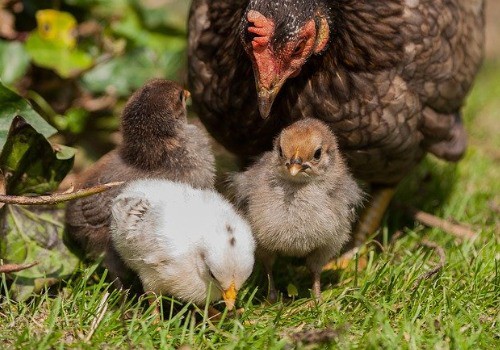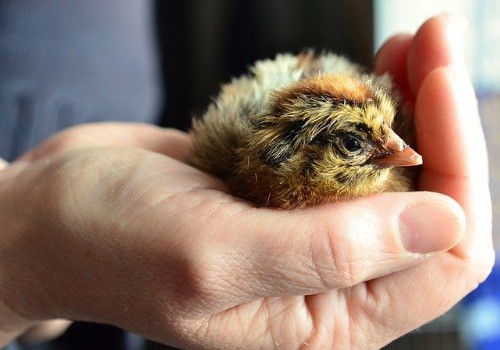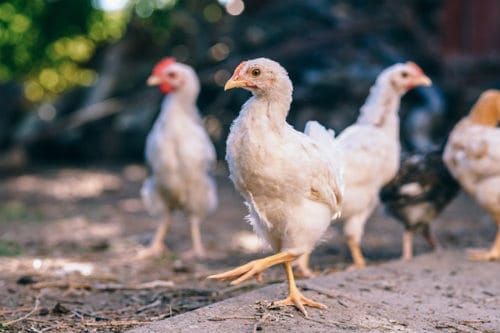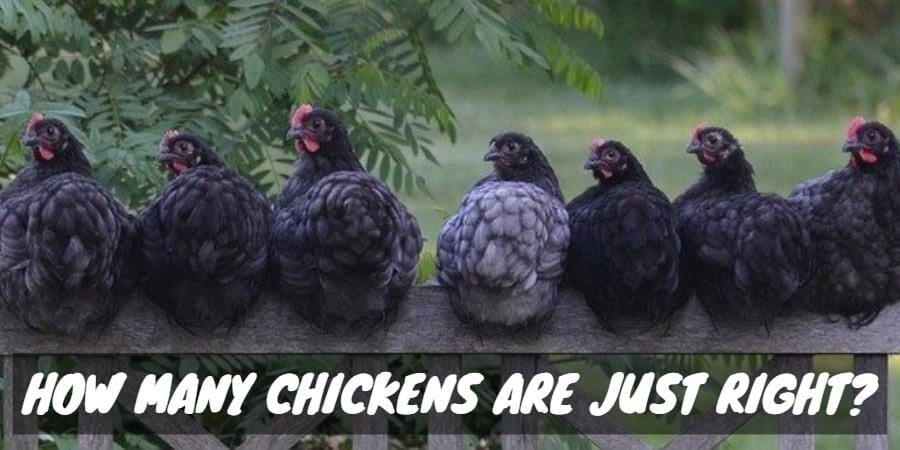In this article, I’ll discuss some of my hard-learned best practices for catching chickens. It’s not difficult, but doing it right is important for the safety of the animal.
The Best Case
Chickens are easiest to catch when they’re hand-tame and bonded to you. This will make it easier to handle the chicken for medical needs or to round up the birds after a day of free-ranging in the yard. If your chickens aren’t easy to handle, you may need to use tools like a pole, net or trap.
The Next Best Case
Chickens are easiest to catch at night after they’ve settled on the roost. Here’s how to do it.
Sneak quietly into the coop with a flashlight pointing at the floor to avoid disturbing the other birds. Approach the hen you need to catch and grab her with your hands over each wing. Holding the wings against the chicken’s body will prevent her from flapping and struggling in a way that could hurt either her or you. It will also do the least damage to her feathers.
When You Need to Be Creative
You might need to get more creative if you need to catch a chicken during the day.
A hen that doesn’t want to be caught can be very challenging to grab. Chickens are quite fast, and they’re surprisingly agile for such chubby birds. Out-running a chicken is rarely a successful strategy.

A good way to catch a hen is to approach her quietly and steadily from behind. You may notice her crouching down and raising her wings. This is the posture a hen assumes before being mounted by a rooster. A quiet human can sometimes stimulate the same instinctive response. If you see a hen take this position when you hover over her, you should be able to bend down and grasp her over the wings with both hands and pick her up without protest.
Techniques for Catching a Chicken Who Doesn’t Want to Be Caught
Sometimes gently grabbing a chicken with your hands simply won’t work.
If you need to catch a chicken that has escaped or that needs timely veterinary care, for example, you might not have the luxury of waiting for her to go to roost.
If you need to catch a chicken quickly, a good option may be a snare.
You can buy a snare or fashion one by attaching a slip-noose to one end of a pole. The poles used by dog catchers will work for this purpose. use the slip-noose to catch the chicken’s feet and pull her close.
A fishing net on the end of a long pole can also work well for catching a chicken and requires less precision. Just wait until the chicken has stopped moving and throw the net over her body. Just be prepared to detangle the chicken from the mesh afterward.
How to Catch a Chicken Like a Pro (Video)
If you don’t need to handle the chicken but need to move her from one area to another, it may be easier to herd or corral the chicken than trying to pick her up. Approach the bird from the side opposite where you want her to go, keeping your arms spread out at your side. The chicken will most likely shuffle out of the way and head where you want her to go.
One good thing about chickens is that they prefer to roost in the same place at night. This means that you probably won’t need to worry too much about rounding up your hens at the end of the day. A chicken will usually go back to the roost on her own once the sun starts to go down.
How to Catch an Escaped Chicken
If you have a chicken that’s flown the coop, you might have an easier time trapping it than trying to chase it down. If a chicken escapes from your yard, she might not be easy to catch.
Humane traps like those used for feral cats or raccoons are a good option for catching a stray chicken. Be sure to fill the trap with an enticing food treat and place the trap somewhere near where you know the chicken to be. If you don’t own a trap, you can usually rent one for a low price. Ask your local humane society for tips on where to find a trap and how to use one if you’ve never used it before.
[amazon bestseller=”humane traps”]
If you’ve had the chicken for a long time, she may return to roost at the coop. Make it as easy as possible for her to return. If she isn’t used to staying in the coop, she may choose a different place to roost. See if you can find where she’s spending her evenings in your neighborhood as it’s likely she’ll return to that spot each day. Chickens are creatures of habit and rarely wander far from their established territories. If you find your chicken roosting in a neighbor’s bushes, you might have an easier time catching it at night than you would during the day.
If your chicken is hand-tame, you might be able to get her to come to you by calling or enticing her with a treat. Sit calmly in a chair near the chicken and scatter food or treats around your feet. When she approaches to inspect the food, you might be able to bend down and catch her.
How to Carry a Chicken

Catching a chicken is just the first step. Once you’ve made the initial grab, you’ll need to take care to hold the chicken properly so that she can be carried or handled safely. Improperly handling a chicken can lead to injuries for both of you.
Some birds like to be held. Most are not this cuddly. A chicken can squirm, flap, and even peck or claw at you. Taking steps to avoid that sort of unruly behavior will go a long way toward protecting you both.
The best way to catch a chicken is with two hands placed over each wing. This prevents flapping. If you’re carrying the bird a short distance, continuing to hold her in this way should work fine. Hold the chicken a little ways away from your body to protect your forearms and torso from potential pecking or scratches.
If you need to have one hand free to medicate the bird or accomplish husbandry tasks, you’ll want to manipulate her so that she’s facing you. Tuck her between your ribs and upper arm, with her head under your armpit. You can apply gentle pressure with your elbow to keep her wedged in place. Using the hand on that side, grasp the chicken’s legs between your fingers. This will provide stability and prevent the chicken from kicking and scratching you.
Never carry a chicken upside down. Holding a chicken by the legs and dangling it upside down may appear to have a calming effect on the bird, but the reality is much less pleasant. A chicken’s lungs rest very close to the spine, and an upside-down bird has a lot of pressure placed on her internal organs. The reason that chickens get calm when held upside down is that they cannot breathe very well in that position.
You should also avoid grabbing a chicken by the wings or neck. Birds are very delicate and have bones that are easily broken or wrenched out of place. Grasping the bird too firmly can also damage her feathers.
How to Hand-Tame a Chicken

When you think of affectionate pets, chickens probably don’t come to mind. However, chickens can grow quite find of their keepers and can develop a bond over time. Bonding with your chickens is a good idea as it will make it easier to catch the chicken when necessary.
A chicken that’s easier to catch is also one that’s easy to medicate, examine, treat for lice or otherwise handle for necessary husbandry. An easy-to-catch chicken is also a blessing in the event of an escape. For this reason, it’s in your best interests to spend some time hand-taming your chickens, even if you didn’t plan on getting them as friendly pets.
The easiest way to tame a chicken is to start when it’s young. Buying your hens as day-old chicks will make them more likely to bond to you.
Daily handling will get your chickens accustomed to you. Chicks that are held on a regular basis will be more docile as adults in most cases.
Whether you buy chickens as young chicks or older hens, a good way to tame them is by hand-feeding. If you feed your chickens by hand, they’ll quickly associate you with food. They’ll get excited to see you and may come running when you approach. This will make it much easier to catch them when you need to.
[amazon bestseller=”chicken feed”]
Some chicken breeds are friendlier than others. This is something to consider when buying chicks. Silkies, ornamental bantam breeds, and Orpingtons are all especially friendly pets. Orpingtons are also very good layers for backyard chicken farming, making them a good starter breed for anyone looking to raise their own chickens.
Individual chickens will have their own unique personalities, and birds that weren’t handled enough as chicks may never be fully hand-tamed. However, building up a trusting relationship with your hens is still possible. It’s worth taking the time to hand-feed the birds and be gentle and patient with them to minimize stress and maximize positive associations. This will make it easier to catch the chickens when you need to handle them.
Are Roosters Harder to Catch?

Roosters can become very aggressive. In their natural habitat, chickens tend to live in flocks of hens with a single rooster protecting the flock. If a rooster perceives you as a threat, he may become aggressive toward you.
Roosters are more dangerous than hens because they have spurs. These are long, sharp growths similar to claws on the back of the leg. These spurs can easily cut you if the rooster decides to attack.
Not all roosters are aggressive, but many are. Their aggression and natural weapons makes them a bit more difficult to catch. Unless you plan to breed your own chickens, it may be a good idea to avoid keeping an adult rooster in your flock.
Keeping only hens will make it easier to catch and handle your chickens when needed and reduce your chances of being injured.





I love chickens
Awsome stuff